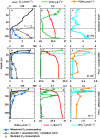Aerobic Microbial Respiration In Oceanic Oxygen Minimum Zones
- PMID: 26192623
- PMCID: PMC4507870
- DOI: 10.1371/journal.pone.0133526
Aerobic Microbial Respiration In Oceanic Oxygen Minimum Zones
Abstract
Oxygen minimum zones are major sites of fixed nitrogen loss in the ocean. Recent studies have highlighted the importance of anaerobic ammonium oxidation, anammox, in pelagic nitrogen removal. Sources of ammonium for the anammox reaction, however, remain controversial, as heterotrophic denitrification and alternative anaerobic pathways of organic matter remineralization cannot account for the ammonium requirements of reported anammox rates. Here, we explore the significance of microaerobic respiration as a source of ammonium during organic matter degradation in the oxygen-deficient waters off Namibia and Peru. Experiments with additions of double-labelled oxygen revealed high aerobic activity in the upper OMZs, likely controlled by surface organic matter export. Consistently observed oxygen consumption in samples retrieved throughout the lower OMZs hints at efficient exploitation of vertically and laterally advected, oxygenated waters in this zone by aerobic microorganisms. In accordance, metagenomic and metatranscriptomic analyses identified genes encoding for aerobic terminal oxidases and demonstrated their expression by diverse microbial communities, even in virtually anoxic waters. Our results suggest that microaerobic respiration is a major mode of organic matter remineralization and source of ammonium (~45-100%) in the upper oxygen minimum zones, and reconcile hitherto observed mismatches between ammonium producing and consuming processes therein.
Conflict of interest statement
Figures



References
-
- Lam P, Kuypers MMM. Microbial Nitrogen Cycling Processes in Oxygen Minimum Zones. Ann Rev Mar Sci. 2011;3: 317–347. - PubMed
-
- Helly JJ, Levin LA. Global distribution of naturally occurring marine hypoxia on continental margins. Deep Res. 2004;51: 1159–1168.
-
- Karstensen J, Stramma L, Visbeck M. Oxygen minimum zones in the eastern tropical Atlantic and Pacific oceans. Progr Ocean. 2008;77: 331–350.
-
- Gruber N. The Dynamics of the Marine Nitrogen Cycle and its Influence on Atmospheric CO2 In: Follows M, Oguz T, editors. The ocean carbon cycle and climate, NATO ASI Series. Dordrecht: Kluwer Academic; 2004. pp. 97–148.
-
- Moore CM, Mills MM, Arrigo KR, Berman-Frank I, Bopp L, Boyd PW, et al. Processes and patterns of oceanic nutrient limitation. Nat Geosci. 2013;6: 701–710.
Publication types
MeSH terms
Substances
Associated data
LinkOut - more resources
Full Text Sources
Other Literature Sources

